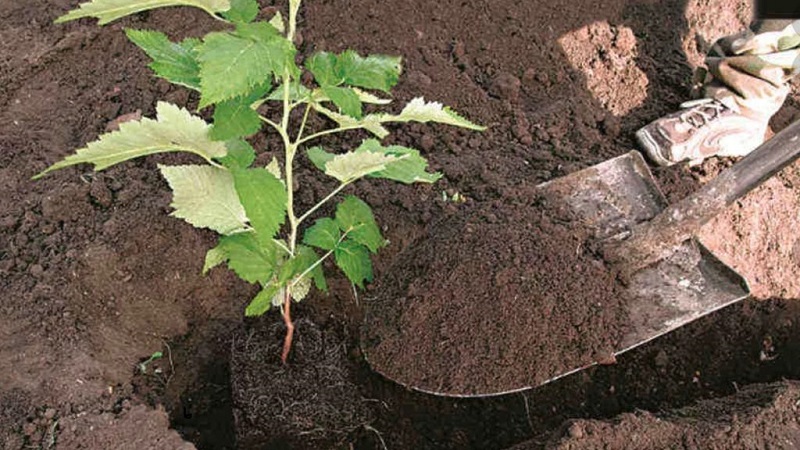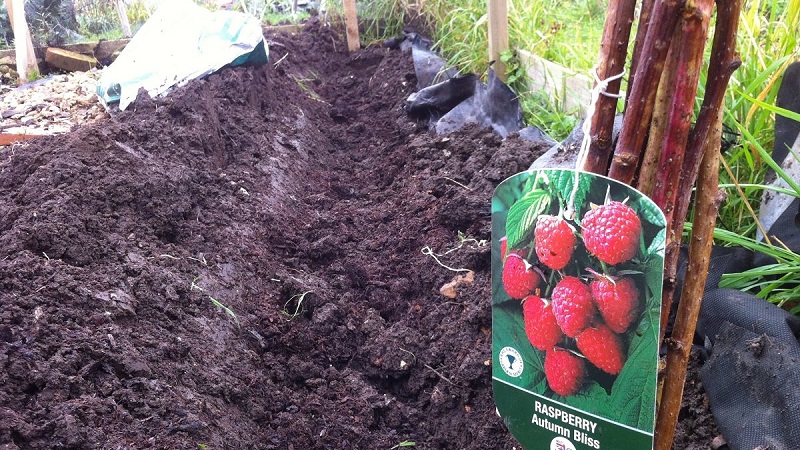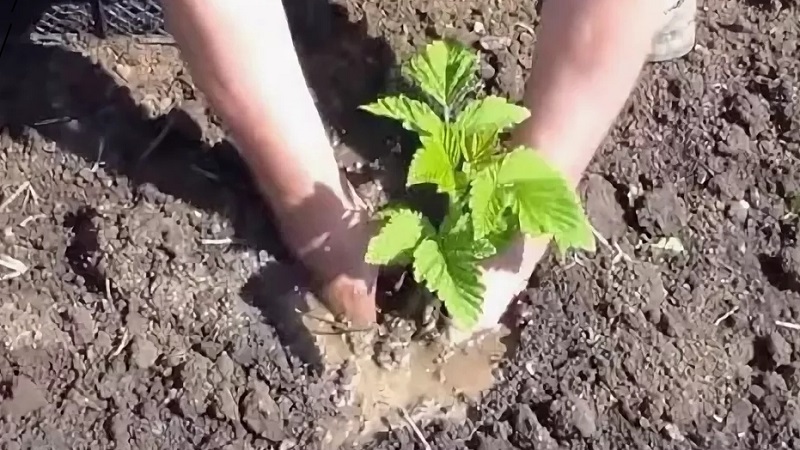Instructions for the correct planting of raspberries in the summer for beginner gardeners
Fruit and berry plants are planted mainly in early spring or mid-autumn. However, every year more and more summer residents are postponing the planting of shrubs for the summer - a warm and carefree time. Raspberries in this case are no exception: subject to all agrotechnical recommendations, they take root well on the site and after a year pleases gardeners with tasty and beautiful fruits. When you can plant raspberries in the garden and how to do it correctly, we will tell you in the article.
The content of the article
- Is it possible to plant raspberries in the summer
- Is it possible to transplant
- Landing dates
- Choosing and preparing a place for planting bushes
- Shoot planting
- Landing pit requirements
- How to plant raspberries in the summer
- How to properly transplant to a new place
- Favorable neighbors
- Planting nuances depending on the type of raspberry
- Care after landing
- Experienced gardening tips
- Conclusion
Is it possible to plant raspberries in the summer
If in the spring on planting raspberries not enough time, you can do it in the summer... Harvest in the year of planting is not expected, but next season the plant will give gardeners the first fruits. Raspberries are planted in June or July.
Advantages and disadvantages of summer landing
In summer, frosts are very rare, so the probability of freezing of seedlings is small... This is true for central Russia and the northern regions. Summer is short there, so it is recommended to plant raspberries from mid-June to July, when the ground warms up.
In warm weather, seedlings adapt well to external conditions and take root, the root system develops quickly. Such raspberries are less likely to get sick and give a good harvest in the future.
The disadvantage of summer planting is that only seedlings with a closed root system are used for it. They are sold in specialized garden nurseries. Raspberries with an open root system will not take root, they will often hurt.

Is it possible to transplant
Transplant raspberries in the event that her yield decreases, diseases often occur, the taste of the fruit deteriorates. Experienced gardeners recommend doing this once every 5 years.
In the summer, you can carry out the procedure only if you dig up and fertilize a new area in advance., select strong shoots up to 10 mm in diameter with developed roots. They are preliminarily shortened and placed in the prepared pits.
Landing dates
The sooner you plant raspberries, the more time before the onset of cold weather, which is why gardeners choose June. The procedure is performed early in the morning, before sunrise. There should be no wind, rain or other precipitation.
Many summer residents are guided by the lunar calendar. Auspicious days in 2020 - June 9, 10, 11, 21, 22, 23, 24.
Choosing and preparing a place for planting bushes
The place for raspberries should be well lit, warm, fertile and protected from the winds... It is recommended to place raspberries along the border with other adjacent areas.
The relief should be flat or slightly hilly; on higher elevations, raspberries suffer from a lack of heat. The depth of groundwater is no more than 1 m, otherwise the plant is often sick and has a weak immune system.
On the north side of the plantings, a fence or garden structures are placed - they protect raspberries from gusty winds. The distance between seedlings is not less than 1 m, between rows - 2-3 m.
Attention!Summer residents dig a hole 50 cm deep and 60 cm in diameter. 10 cm of crushed stone or broken brick is poured onto the bottom, a layer of sand. Drainage improves the air permeability of the soil, making it lighter and more nutritious.
The choice of planting material
Summer residents choose one-year or two-year-old raspberry seedlings with a closed root system. They are sold in containers.
Saplings have a bare stem 20 to 40 cm long... The thicker it is, the stronger the bush will be. The recommended diameter is at least 0.8 cm. At the base of the stem there should be pale green buds - the beginnings of new shoots.
Healthy plant roots are moist and dense, without traces of rot and freezing. Since the seedlings are sold in pots, the best sign of healthy roots is bulging through the drainage holes.
Shoot planting
The method is used for planting in warm regions with nutritious soil... Young shoots with lumps of soil are dug from the fruiting site and transplanted into prepared trenches or holes. For rooting, they are abundantly watered with warm water and fertilized with a mineral complex. By autumn, the bushes take root and give new shoots.
Planting in this way is not common among summer residents; it is used only when breeding valuable varieties.
Cuttings
Cuttings for summer planting are prepared since spring - the roots are carefully dug up and cut into pieces of 15-20 cm. The cuttings are stored in a cool and dark place, left in a container with clean sand. In summer, they are laid out in prepared pits with a depth of 10-12 cm.

Distance between cuttings about 20 cm... The grooves are covered with loose soil and watered abundantly. During the summer, the soil is regularly loosened to a depth of no more than 5 cm, so as not to touch the still weak cuttings. By the fall, they grow and the next year they give the first harvest of raspberries. Planting by cuttings is more common among summer residents than by shoots.
Seeds
Planting with seeds relevant if it is not possible to get shoots or cuttings of raspberries... In this way, seedlings are grown at home - containers, seeds, land are prepared.
Planting seeds for seedlings looks like this:
- The berry is ground through a sieve, the seeds are separated from the cake and soaked in water.
- When the seeds are swollen, it is drained.
- The largest specimens are chosen and germinated - placed in moist warm gauze for 2-3 days.
- Fill a peat glass with garden or purchased soil and pour boiling water over it.
- After germination, the seeds are placed in the ground, fertilized with a weak solution of bird droppings.
Seedling care consists of watering and fertilizing... Ready-made seedlings have a root system of at least 10 cm. They are placed on the site on a warm day, 2-3 seedlings are sent to one hole at once. In the coming of autumn, cover with foil.
Landing pit requirements
The planting pit is prepared 2-2.5 months before planting... To make the soil nutritious and fertile, 15 kg of rotted manure, 80 g of superphosphate and 40 g of potassium sulfate (per 1 sq. M) are added to it. If the soil is clay, then 20 g of manure is taken, if sandy - 12 kg. A hole is dug, a drainage layer is laid on the bottom. If there is no manure, then add 10 kg of compost or humus.
Attention!The planting site is cleaned of weeds and foliage, all debris is removed and burned. Some summer residents neglect digging and, as a result, get a raspberry patch full of pests and weeds.
How to plant raspberries in the summer
Before planting, summer residents prepare the necessary tools, planting material... You will need a shovel, a bucket of water, a rake to level the earth. Summer residents use water at room temperature - if you water a seedling cold, it will get sick.
Step-by-step planting instructions
After the planting material and tools are ready, gardeners start landing:
- The seedlings are soaked in mullein solution.
- They are lowered into the prepared hole.
- Hands gently spread the roots in a horizontal position.
- Sprinkle with loose earth.
- They level it, leaving one hilly area near the shoot.
- Water abundantly.
- Mulch with cut grass, hay, sand, wood ash.
Landing methods
Planting method depends on the number of seedlings and the size of the garden area... Most often, summer residents use a bush or trench, less often - in a container or on a trellis.

Planting methods:
- Bush... Summer residents prepare holes 50 cm deep, observing the distance between them 2-3 m. Fertilize with organic matter and place the seedling inside. The most common method, suitable for small areas.
- Trench... The depth of the trench is 45 cm, the width is about 50 cm, the distance between the plants is 40-50 cm. The trench is fertilized with a mixture of manure, compost, humus and peat - the layer thickness is 15 cm. Then the seedling is placed. In the container. Use a plastic or metal container without a bottom. Previously, it is disinfected with a solution of Bordeaux mixture. The container is placed in a pre-prepared planting pit. Pour fertile soil inside, place raspberries.
- On the trellis... This method is combined with a trench. After planting, the seedlings are tied up on a trellis. This helps to avoid diseases and increases future yields. Wooden or metal posts are used as trellises.
- Tape... Plants are placed at a distance of 30 cm from each other. The empty areas are soon filled with replacement shoots that form a solid wall. In old tires. The tire is half-deepened into a pre-dug hole, filled with a mixture and seedlings are placed in the center. Tires are convenient in that they retain moisture and liquid fertilizing.
How to properly transplant to a new place
To transplant the plant, the shoots are shortened by 20 cm and the young growth is removed... Most often, the belt, bush or trench method is used.
Prepare the pits - fertilized with peat and humus, watered abundantly with water. The bush is placed in a hole along with an earthen lump, the root collar is deepened and sprinkled with earth, tamped and watered again. It is recommended to plant raspberries in a place where nothing has grown before. If there are no "clean" areas, then choose the soil after mustard, cucumbers, legumes, herbs, onions and garlic.
Do not transplant raspberries to those places where other berry bushes used to grow, as well as potatoes, peppers, eggplants... The soil must be at a neutral level of acidity, otherwise liming is required. Wood ash fertilizes the soil well.
Attention! To make the bushes better take root in a new place, they are sprayed with a complex fertilizer for fruit and berry bushes or a solution based on wood ash and nettle.
Favorable neighbors
Raspberries are planted nearby with pear, apple, plum. Another excellent neighbor is dill, it attracts pollinating insects to the raspberry garden, which has a good effect on productivity.
Unsuitable neighborhood for a plant - bushes of cherry, sea buckthorn, black currant, blackberry, strawberry and wild strawberry. Plants have common diseases and pests. It is not recommended to grow potatoes nearby - it inhibits the development of the bush.

Planting nuances depending on the type of raspberry
If a common varieties raspberries take root on the site without any problems, then the cultivation of remontants requires strict adherence to all conditions. Such raspberries bear fruit only in spacious areas and fertile lands.
The planting pit is fertilized in late autumn and springso that by summer it has accumulated vitamins and microelements useful for raspberries. The site must be sunny, even in partial shade remontant raspberry grows poorly. The plant is planted to a depth of 30 cm. Such raspberries receive nutrition through the lateral roots, so it is not recommended to deepen them.
Depending on the region of cultivation
If raspberries are planted in cold regions, for example in the Urals or Siberia, then seedlings are pre-soaked in a clay mash. It increases the plant's resistance to sudden changes in temperature, strengthens the immune system and protects against diseases and pests. It is easy to prepare the product: mix clay and water until the consistency of thick sour cream. Also, it is easy to store and transport planting material in a talker.
In central Russia, it is recommended to pay attention to garden soil... It must be clean and nutritious. To increase its fertile properties, summer residents mix garden land with purchased land, add 20 g of superphosphate and 10 g of nitroammophoska per 1 sq. m.
Care after landing
5 days after planting, the raspberries are hydrated... They use drip irrigation; about 5 liters of water are consumed per bush. It is important not to overdo it, otherwise it will lead to the development of fungal diseases.
Before watering, the soil is loosened to a depth of 5-7 cmso that the water penetrates deep to the roots and stays there. The optimal time for the procedure is early morning or evening after sunset.
After 10 days, the raspberry plant is fed with nitrogen and phosphorus-potassium fertilizers... Use ready-made complex preparations or ash, phosphate rock, urea, nitroammofosk, double superphosphate, potassium salt - 20-25 g of dry fertilizer per 1 sq. m. In the first 2 weeks, it is recommended to treat raspberries with insect and disease agents.
Use a solution of Bordeaux liquid or tobacco leaves, and the drug "Fitosporin". Effective in processing and garlic-herbal solution - for 10 liters of water requires 300 g of peeled garlic and 3 kg of cut grass. The mixture is infused during the day and used for spraying. The next processing is carried out only in August.
Experienced gardening tips
So that planting and replanting raspberries to a new place does not cause trouble, experienced gardeners recommend to observe the following rules:
- carefully choose seedlings - the stems should be even, elastic, light brown;
- disinfect garden tools and soil;
- choose days without rains and winds for the procedure;
- keep the distance between shrubs;
- fertilize planting pits;
- follow the recommendations for the neighborhood;
- pruning before summer transplant.
Conclusion
Growing a delicious raspberry crop is easy if you follow the step-by-step planting guide. In summer, only seedlings with a closed root system are used. The plot is found sunny, slightly hilly, sheltered from the winds. Depending on the size of the garden, tape, bush or trench placement is chosen. Some summer residents plant raspberries in pots or old tires. The planting pit is prepared in advance - fertilized with manure, peat, humus. The seedling is watered, and after 10 days the first feeding is applied. Harvesting is expected in exactly one year.